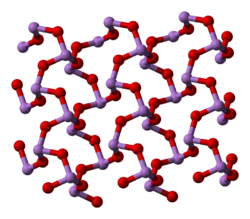Chemistry:Claudetite
From HandWiki
| Claudetite | |
|---|---|
 | |
| General | |
| Category | Oxide minerals |
| Formula (repeating unit) | As2 O3 |
| Strunz classification | 4.CB.45 |
| Crystal system | Monoclinic |
| Crystal class | Prismatic (2/m) (same H-M symbol) |
| Space group | P21/n |
| Unit cell | a = 5.33 Å, b = 12.98 Å, c = 4.54 Å; β = 94.27°; Z = 4 |
| Identification | |
| Color | Colorless to white |
| Crystal habit | Thin tabular crystals, fibrous crusts |
| Twinning | Contact or penetration on {100} |
| Cleavage | Perfect on {010} micaceous |
| Fracture | Splintery |
| Tenacity | Flexible |
| Mohs scale hardness | 2.15 |
| |re|er}} | Vitreous, pearly on cleavage surfaces |
| Diaphaneity | Transparent |
| Specific gravity | 4.14–4.15 |
| Optical properties | Biaxial (−) |
| Refractive index | nα = 1.870 nβ = 1.920 nγ = 2.010 |
| Birefringence | δ = 0.140 |
| 2V angle | 58° (measured) |
| References | [1][2][3] |
Claudetite is an arsenic oxide mineral with chemical formula As2O3. Claudetite is formed as an oxidation product of arsenic sulfides and is colorless or white. It can be associated with arsenolite (the cubic form of As2O3) as well as realgar (As4S4), orpiment (As2S3) and native sulfur.[1]
It was first described in 1868 for an occurrence in the San Domingo mines, Algarve, Portugal. It was first described by and named for the French chemist Frederick Claudet.[2]
References
- ↑ 1.0 1.1 Handbook of Mineralogy
- ↑ 2.0 2.1 Claudetite data on Webmineral
- ↑ Claudetite on Mindat
- ↑ Warr, L.N. (2021). "IMA–CNMNC approved mineral symbols". Mineralogical Magazine 85 (3): 291–320. doi:10.1180/mgm.2021.43. Bibcode: 2021MinM...85..291W.
 |

